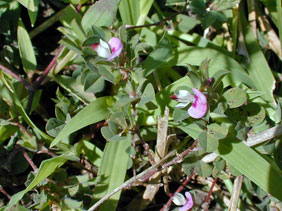KOREAN LESPEDEZA
|
 |
| File Size: 97 KB |
|
|
|
Kummerowia stipulacea (Maxim. ) Makino
|
| [=Lespedeza stipulacea Maxim.] |
| Greenwood County, Kansas |
| Annual |
| Height: 4-24 inches (usually 4-12 inches) |
| Family: Fabaceae - Bean Family |
| Flowering Period: July, August, September,October |
|
| Also Called: | | Korean clover. | | Stems: | | Erect or ascending, 4 to 24 inches tall, branching, dense to sparse pubescence appressed upward. | | Leaves: | | Alternate, palmately-compound, trifoliolate; main leaves on stalks 1/5 to 2/5 inch long; leaflets spatulate to obovate, 1/3 to 1 inch long, 2/5 to 7/10 inch wide, glabrous; margins and lower midrib of younger leaflets with conspicuous fringe of hairs; stipules ovate to ovate-lanceolate, about 1/4 inch long, ridged, mostly glabrous. | | Inflorescences: | | 1-3 flowers in leaf axils near branch tips; flowers of two types, one with petals, one inconspicuous, without petals. | | Flowers: | | Calyx bell-shaped, 5-lobed; corolla papilionaceous; petals about 1/4 inch long; banner petal pinkish to purplish with darker base; wing petals white; keel petals white, tips dark-red. | | Fruits: | | Pod, egg-shaped, 1/8 inch long, minutely pubescent, half covered by calyx; seed smooth, shiny, brown or black. | | Habitat: | | Roadsides, fields, pastures, and open woods; sandy soils. | | Distribution: | | Principally east 1/3 of Kansas. | | Uses: | | Bob-white quail and wild turkeys eat the seeds. | | Comments: | | The leaves point forward at maturity, coming together to resemble a cone. Native of Korea; introduced into the United States in 1919 as a hay and pasture plant. Korean lespedeza will spread rapidly. |
|
| Korean lespedeza |  | | 89 KB | | Greenwood County, Kansas |
| | Korean lespedeza |  | | 123 KB | | Atchison County, Kansas |
| | Korean lespedeza |  | | 121 KB | | Atchison County, Kansas |
| | Korean lespedeza flowers |  | | 125 KB | | Atchison County, Kansas |
| | Korean lespedeza habit |  | | 247 KB | | Atchison County, Kansas |
|
|
|
|
|
|
|







